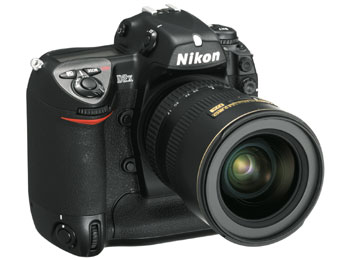
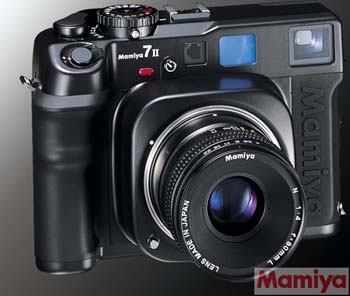
Nikon D2X versus Mamiya 7
On the other hand there were tests which said that well scanned 35mm films are almost similar with those same cameras. A rather unexplainable matter. Clearly was, however, that with or without set-up the tests had been carried out frequently badly. Medium format 6x7 cameras were not always equipped with the best lenses and often there were doubtful reasons for downsizing to make the images similar to each other. There is even a test where the photographer photographs through the window, and who knows how clean this window was !?
The slides of the Mamiya7 i see are very sharp and detailed. It seemed the right time to do some study myself. It had to become a test as honest as possible, without postulated outcome and commercial interests. The aim of this test is therefore to examine to what extent 6x7 qualitatively can measure itself with a modern 12 Mpxel camera such as the Nikon D2x. I do not have the intention to make any statement whether digitally is better than analog, or the other way around. Both have a another use aim.
For both cameras, we tried to make a good test situation, though always keeping in mind the practical approach. I used a firm tripod, good lenses, optimum diaphragm, mirror lock up with the Nikon etc. We have done our best.
Concerning scanning, the opinions diverge what is the best method. Scanning is a very important factor for the final result. The price will be an important factor for a lot of people. It is clear that a cheap scan, like the Epson flatbed, does no right to the qualities of 6x7. On the other hand a drumscan is seen as too expensive for daily use. Since this is a qualitytest between analog and digital, there has been chosen for an ICG drumscan and for an Imacon flexscan.The difference can be seen immediately between both. On this page you can see the large difference between an Imacon scan and an ICG drumscan
At several places you can hire the Imacon scanner, at a certain price per hour, making the price per slide very acceptable. For a single real large print, a drumscan nowadays does not really cost too much. At professional photolab Capi in Amsterdam a 100mb scan will cost you 45 dollar. For a 31x47 inch (80x120 cm) print, the price of the scan is 25% of your total costs, what seems acceptable to me. The first photograph from the test photographs below, with the boat, has been scanned with ICG drumscan. The photograph with the bottles has been scanned with an Imacon 848. , the first test photograph of the boat has been scanned with both scanners.
Working method.
- Film. Fuji 100 asa Astia. This film has a slightly larger dynamic range than for example a Velvia. Very little grain and good to scan.
- Noise reduction of the analog film. There has been chosen for direct filtering the film using NEAT software. This programme does a great job in reducing grain. Although grain certain has its value, after (moderate) filtering you see much detail coming out which formerly remained hidden in the grain. Here is an example. We used a moderate noise reduction (50%) in combination with a small sharpening (conservative) in the high frequencies. By reinforcing the high frequencies, contrast can still be good at the smaller details, making the image much sharper without too much side effects, or too exuberant sharpening effects.
We choose for the Mamiya 7 as a reference for 6x7 the format. The Mamiya 7 is well known for its quality objectives. We used the 65 mm on F11 which obtains in the picture centre approximately 100-120 lp/mm. On photodo web site the Mamiya Lenses are classified in the highest category. Visit this web site for the lp/mm of the Mamiya lenses (and more)
We choose the Nikon D2x to compare. Just a choice. Of course it 's not the defacto standard for 12Mpixel camera's but nevertheless there seems not a lot of difference between Canon and Nikon. Although the test reveals better edge-sharpness for the Nikon. See (Dpreview test nikon D2x) Between the Canon 1Ds 12mp and the Canon 1Ds Mark II 16.5 mp is (of course), a difference but this also is very small. Here is a comparison between the Canon 1Ds and the Mark II I think the results of the test would have been not that much different if we had choosen for a Canon 12 or 16.5 mpixel camera.
We worked with the 18-35mm lens on f11 and f8. It seems that the f111 is a bit sharper. It is generally considered to be a very sharp lens especially in the image centre, the sweet spot. Because the Nikon D2x uses a sensor area of 23.7 x 15.7 mm only the image centre of this lens is used. A lot of practical Nikon lens tests can be found on the site of Bjørn Rørslett. ,where also the Nikon D2x has been tested. I did some tests with the Nikon 18-35 to justify it's use for this test.
Post-processing.
The Nikon raw files have been processed in Adobe raw converter, Bibble and Phase-one. Although Bible took away the the color - fringle very well the sharpest results with Phase one software were nevertheless obtained. The Nikon files have been moderately sharpened in Phase one. To be represented just as large as the Mamiya scans the Nikon files are resized to approximately the format of the Mamiya. At 100% the Nikon image had to be the same size as the Mamiya. We worked in 8 bits.
The 65mm lens of the Mamiya has a slightly larger picture area than the Nikon 18-35 in 24mm. Consequence is that the Mamiya something ' sees ' more and that the Nikon D2X has a slight advantage of approximately 10%. Not important for this test. The colour of the images are made equal as much as possible
Scanning of film
The Mamiya transparencies have been scanned on two scanners. Imacon flextight 848 and on ICG drumscanner. The scanresolution on the Imacon was 3000 dpi. This is not the optimum resolution to obtain ' everything ' from the transparencies but practical. It provides files of approximately 150mb (8 bits), still easy to handle. The scan on the ICG drum has been carried out on a value of 2400 dpi. This provides a file of approximately 100mb. The reason for this is for practical considerations; these scans are still payable. The drum scan is resized to 8200 pixels. This is large enough for 41 inch (104cm) print at 200dpi. It seems that the Imacon satisfies well at high contrast transparencies such as the bottles. These are very sharp on the Imacon. The scan of the boat is however considerably better with the drumscan. The edge definition of the drumscan is considerably better. There is a lot of 'Blooming, with the Imacon making the image to look soft. On this page you can see the difference between the Imacon flextight ccd scanner and the ICG drum scan .
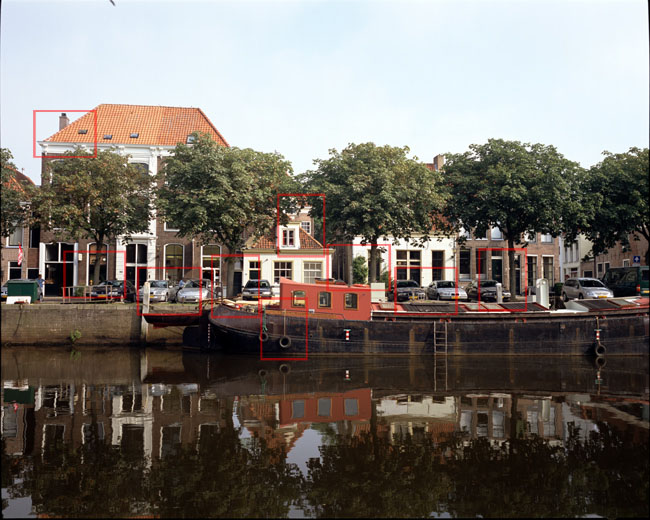
65mm F11
Drum scan ICG 2400 dpi
5350x6670 pixels
de-noised and sharpened in Neat.
Download this picture full size.
This picture is made in the Netherlands. Here is the GPS location.
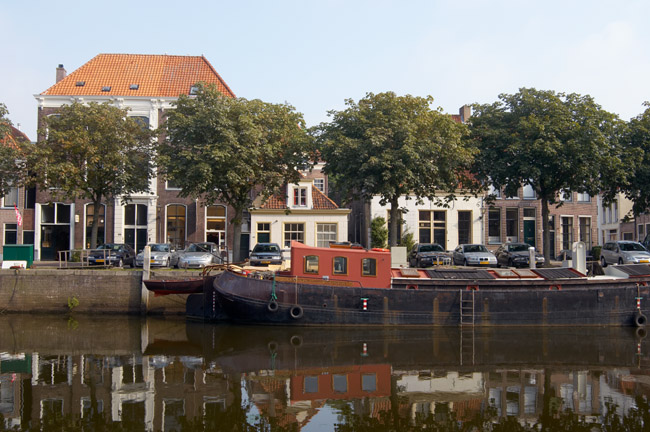
Raw image converted to 8 bits TIFF with Phase one 3.7.1
4200 pixels resized about 180% to match the Mamiya scan
Nikon 18-35 24mm on F11
When you look to the details you can easily see that the Mamiya is considerably sharper than the Nikon D2x. By example the watch or the details in the lens of the Yashica camera.The question is; how much more Megapixel is ' a little bit sharper?
When a picture is already sharp with small details, which is normal with a 12mpixel camera, you need a lot of pixels more to see a noticeable difference. On this site a comparison between a Canon 1Ds mark II (16mp) and Betterlight scanning back of 48 Mpixel is made.
In this comparison between Canon and Beterlight you can certainly see some differences. But you talk about 3 times more pixels! The Canon is 16 Mpixel compared to Betterlight 48 Mpixel. The differences in detail of the Mamiya/Nikon D2x test photograph below, with the bottles, are at least of the same magnitude. But to be save i assume a difference in pixels of a factor 2. Also important is the fact that the Mamiya photo has been taken smaller. On the Nikon photo the champagne bottle is 15.3% of the total width. On the Mamiya photo the same bottle is 11.5% of the total width. The same bottle (and all objects) on the Mamiya photo can be made 15,3/11,4 = 1.34 times wider. The number of pixels increases then quadratic: 1.34x1.34= 1.8x.
The Mamiya therefore is in any case 1.8x (12 Mpixel of the Nikon D2x) = 21.5 megapixel.
But because the more detailed image of the Mamiya is sharper and probably 2 times more megapixels (as explained before), the Mamiya has a total number of megapixels of 2x 21.5=43 megapixel.
In short the Mamiya has a total amount of something between 21.5 and 40 the megapixel. That corresponds also very well to the value for 35 mm film, between 6 and 10 megapixel. Since 6x7 approximately is four times larger that produces roughly 24-40 megapixels.
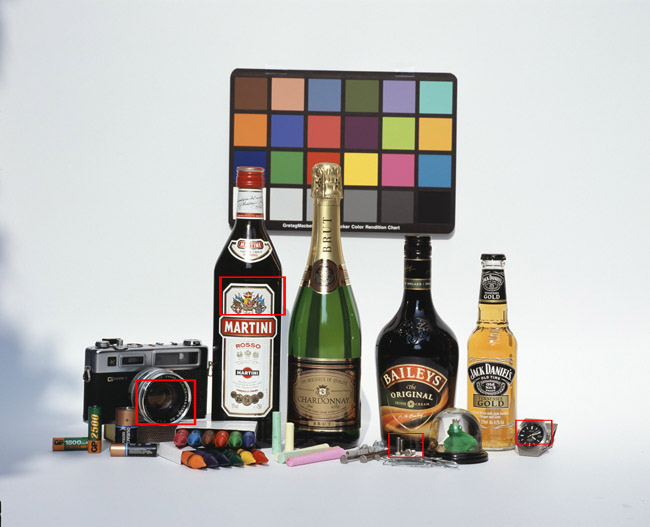
Imacon scan 8200 pixels (300 dpi)
Minimum distance of Mamiya is 1 metre that is why there is so much space around the bottles.
Colorrendering is not perfect because the Imacon was not color calibrated.
Bottles Are 0.75 times the same bottles in the Nikon picture below.
The bottle 'brut' is 11,4% of the total width.
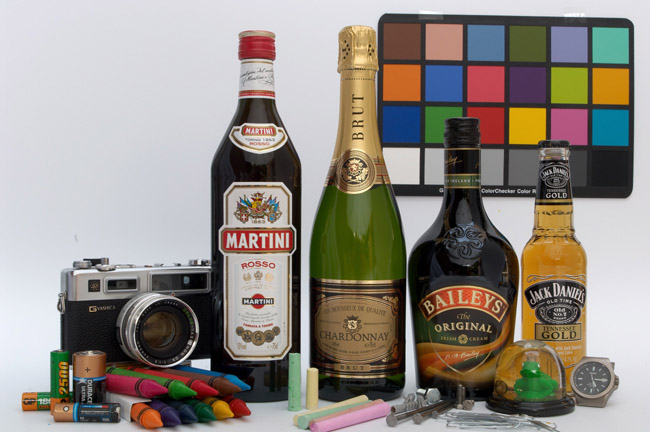
18-35mm with 35mm F8 1/6 sec.
Very good color rendering.
Bottle 'brut' is 15.4% of total width of picture.
Prints.
The photographs on the screen show clearly differences between the cameras. I however also wondered myself what i would see of it when i print it. For this reason the photograph of the boat has been printed on 12x16 inch ((30x40cm) and 24x31 inch (60x80cm. Of the 24x31 only the middlepart has been printed. Sufficient to judge it. All prints were made on a Fuji Frontier. (Soon also high quality prints on Durst Lambda will be made)
Analog prints.
There are no analog prints made. I have some thoughts about it. Although i think that the quality of anolog color prints can be very high i doubt if at this moment (2005) this quality will be achieved. First, in the Netherlands there are almost no photo labs which can make such prints. In other countries this situation can be different of course. It is a question if in the near future there will be enough experience for analog color printing. Second, when a good scan is made then you have a lot of possibilities to make the photo 'better' Removing of too much grain, color adjustment, sharpening and so on. All these nice digital manipulations can have a big impact and, if done right, probably make in the end a better digital print than would be achieved in the normal analog way without all these adjustment. Of course with a good lab and a person knowing what he/she is doing the story is quite different but i am really afraid this will be history in near future. Maybe the 400dpi Lambda print can be more or less compared with analog printing.
Visible differences on the 12x16 prints
With Fuji Frontier at 300 DPI
On 12x16 inch print little difference is seen. That makes sense because the 16 inch print uses approximately 16*300 dpi=4800 pixels. The native resolution of the Nikon D2x of 4200 pixels is already almost sufficient for this, small image resizing is sufficient. Almost no quality is lost. The 8200 pixels of 6x7 scan must be downsized to 4800 pixels to be able to print 16 inch. Of course the quality of the tested camera's come very close this way.
With Durst Lambda at 400 DPI
With the Durst Lamba printed at Capi lab in Amsterdam 12x16 (actually 11,7x16,5) prints were made at a resolution of 400 dpi. This is the highest print quality which normally will be and can be used. These are really high res prints. Prints with this high dpi will probably be a better match with the high quality of direct analog prints made form the tranparancy. The pixel count on this prints is an unbelievable 30 megapixel ( 4680 x 6600 pixels ) The Mamiya files were downsized with bicubic sharp while the Nikon d2x files were upsized using Bicubic smooth (photoshop CS). I used levels to give the Nikon a brighter look. Finally both files got a USM. The prints are amazingly sharp printed with the Lambda on 400 dpi. With a loupe you can easily see very small details of only some pixels which show up on the screen at 100%.What is the best print?. This depends completely of the scanning process. The Mamiya is the winner when it comes to sharpness even at 12x16 inch. Especially the leaves at the trees look much more detailed but this difference is only seen with the ICG drumscanned transparancy. The prints scanned with the Imacon look almost the same as the Nikon prints. Whether you can see this differences depends of the quality of your eyes. I estimate only 20 % of the people will see the differences because you need at least very sharp eyes which can resolve up to 8 lp/mm. Not everybody is capable of this. This is a phenomenon which is largely overlooked when testing cameras. Here you can read my article about perceived print quality verus eye quality.
Visible differences on larger prints.
The higher quality of 6x7 Mamiya can be seen at prints of 24x31 inch (60x80 cm) and larger. There is a difference in print quality between Drumscanned film and Imacon ccd scanned film.
Prints of Imacon scan at 24x31 inch
The print made with the Imacon Flextight 848 scan compared to the Nikon D2x print on 24x31 inch does not show much difference. A compliment for the Nikon or bad performance of the Imacon scanner.If you examine this 24x31 print of near distance (therefore on 10 inch distance) you can see clearly that the Mamiya 7 nevertheless is sharper. The ropes of the boat, de trees, all the small details. However on a normal visibility distance of 12-16 inch that difference almost disappears entirely. I fear a lot of people will not notice the difference.
Prints of Drumscan at 24x31 inch
The print of the drumscan is a complete different story. Here you can see a clear difference between the Nikon D2x and the Mamiya 7, in the advantage of the Mamiya on 24x31 inch format. The more detailed image of the Mamiya 7 makes the picture much crisper to look at. There is more depth in it. The Nikon prints are in comparison of a lower quality, you can see it immediately, you don't have to look very well.
I think most people will see this difference.
Conclusion.
It was a pleasure to work with the Nikon D2x, a splendid camera. Easy to work with, very good colorrendering, very fast. I love it. For daily use and prints up to approximately 16x20 inch (40x50 cm ) there is almost no competition for a digital 12 megapixel camera.
Although the Nikon is a very good camera the winner of this review considering sharpness is the Mamiya 7. When do you need this kind of quality? That depends on the purpose. With larger prints the quality of the medium format 6x7 can be seen. There are subjects where the higher megapixels count of the Mamiya is important, for example nature, landscapes. Landscape needs a lot of detail and therefore many megapixels. Also for black/white the 6x7 format is still unsurpassed.
After having seen all the prints and the scans on the screen it is clear to me that a good 6x7 camera with good lenses has a high resolution and is clearly sharper than a professional 12 megapixel DSLR. Also a Canon 1Ds mark II will not change this, it is only a little bit sharper. You must, however, have the intention to get the best from the Mamiya 6x7 otherwise it is useless to use this format.Well used and scanned with care, large impressive prints can be made
Scanning is a point of attention. The Imacon is a good scanner but not for all kind of work. Not impressive for the money. Imacon has sold the virtually drum idea very well. Unfortunately no drum to see, just a good CCD scanner with all problems of ccd's (dust, blooming) For larger prints a good scan is necessary. Drumscans are in fact the only reasonable solution and nowadays rather payable. The difference with Imacon is sometimes very large dependent on the subject. Drumscans are in any case always the best choice. Although at this moment scanners are not yet perfect, you don't know what will be possible in the near future.
Another approach is the purchase of a payable Epson photoscanner. This website gives a serious test about various scanners in comparison with drumscanners For 12x16 inch it is good enough. In any case you can see your transparencies on the screen. The real top pieces can always be scanned later with a professional drumscan. At Capi in Amsterdam that will cost you 45 dollar.
In any case the 6x7 format has certainly not lost it's use. However maybe, another use in the future. Given the resolution of 40 megapixels large prints of 31x48 inch can be made (at 200dpi). They show a lot of detail .
Some other tests with Medium format compared to Digital 12 mpixels.
Mamiya 7 compared to Canon 1Ds I think it is not a good idea to make a photo through the window. Even a little bit of dirt or scratches on the glass will lower the maximum resolution of the photo. This will have the biggest impact on the camera with the highest resolution, the Mamiya.
Luminous landscape 645 compared to 1Ds This is a well known test and a lot of references on the internet. When i read this test i will immidiately buy a Canon 1ds. Strange i get completely different results.
Various formats compared. 8x10, 4x5 inch, 6x7, 35mm leica, Canon 6mpixel DSLR. Very interesting but medium format and bigger film is scanned with an Epson scanner. The loss in resolution will be too big to get a good comparison. The lens of a Plaubel 6x7 is not very good according to this test with an overview in lp/mm with a lot of medium format lenses. The results of 6x7 and bigger are therefore not showing the real possibilities of these formats.
Pentax 67 versus Canon 1Ds Seems a serious test, 4000ppi nikon scanner.
Hasselblad versus Canon 1Ds. Scanned with a Nikon 8000 scanner on 4000 dpi. The Canon is almost as sharp as the Hasselblad. It is a pitty that the rope is photographed from above /side. In this way the sharpness of the photo depends on the depth of field. Not sure if the shown crop is the sharpest point of picture.
Downloads.
Original photo downloads. The Mamiya file is drumscanned and colorcorrected. Be carefull these are very large files (20mb) and take a long time to download. Please don't download if you don't need them, they cost a lot of bandwith for me.
Mamiya 7 without water and sky minimal Jpeg compressed photoshop 12.
Mamiya 7 without water and sky Lossless Jpeg 2000 !!VERY large
